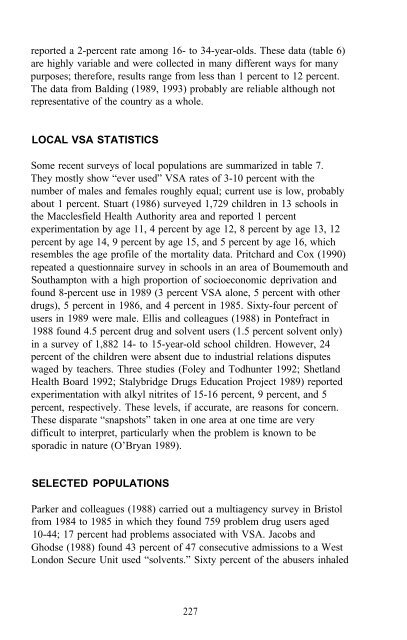Epidemiology of Inhalant Abuse - Archives - National Institute on ...
Epidemiology of Inhalant Abuse - Archives - National Institute on ...
Epidemiology of Inhalant Abuse - Archives - National Institute on ...
You also want an ePaper? Increase the reach of your titles
YUMPU automatically turns print PDFs into web optimized ePapers that Google loves.
eported a 2-percent rate am<strong>on</strong>g 16- to 34-year-olds. These data (table 6)<br />
are highly variable and were collected in many different ways for many<br />
purposes; therefore, results range from less than 1 percent to 12 percent.<br />
The data from Balding (1989, 1993) probably are reliable although not<br />
representative <str<strong>on</strong>g>of</str<strong>on</strong>g> the country as a whole.<br />
LOCAL VSA STATISTICS<br />
Some recent surveys <str<strong>on</strong>g>of</str<strong>on</strong>g> local populati<strong>on</strong>s are summarized in table 7.<br />
They mostly show “ever used” VSA rates <str<strong>on</strong>g>of</str<strong>on</strong>g> 3-10 percent with the<br />
number <str<strong>on</strong>g>of</str<strong>on</strong>g> males and females roughly equal; current use is low, probably<br />
about 1 percent. Stuart (1986) surveyed 1,729 children in 13 schools in<br />
the Macclesfield Health Authority area and reported 1 percent<br />
experimentati<strong>on</strong> by age 11, 4 percent by age 12, 8 percent by age 13, 12<br />
percent by age 14, 9 percent by age 15, and 5 percent by age 16, which<br />
resembles the age pr<str<strong>on</strong>g>of</str<strong>on</strong>g>ile <str<strong>on</strong>g>of</str<strong>on</strong>g> the mortality data. Pritchard and Cox (1990)<br />
repeated a questi<strong>on</strong>naire survey in schools in an area <str<strong>on</strong>g>of</str<strong>on</strong>g> Boumemouth and<br />
Southampt<strong>on</strong> with a high proporti<strong>on</strong> <str<strong>on</strong>g>of</str<strong>on</strong>g> socioec<strong>on</strong>omic deprivati<strong>on</strong> and<br />
found 8-percent use in 1989 (3 percent VSA al<strong>on</strong>e, 5 percent with other<br />
drugs), 5 percent in 1986, and 4 percent in 1985. Sixty-four percent <str<strong>on</strong>g>of</str<strong>on</strong>g><br />
users in 1989 were male. Ellis and colleagues (1988) in P<strong>on</strong>tefract in<br />
1988 found 4.5 percent drug and solvent users (1.5 percent solvent <strong>on</strong>ly)<br />
in a survey <str<strong>on</strong>g>of</str<strong>on</strong>g> 1,882 14- to 15-year-old school children. However, 24<br />
percent <str<strong>on</strong>g>of</str<strong>on</strong>g> the children were absent due to industrial relati<strong>on</strong>s disputes<br />
waged by teachers. Three studies (Foley and Todhunter 1992; Shetland<br />
Health Board 1992; Stalybridge Drugs Educati<strong>on</strong> Project 1989) reported<br />
experimentati<strong>on</strong> with alkyl nitrites <str<strong>on</strong>g>of</str<strong>on</strong>g> 15-16 percent, 9 percent, and 5<br />
percent, respectively. These levels, if accurate, are reas<strong>on</strong>s for c<strong>on</strong>cern.<br />
These disparate “snapshots” taken in <strong>on</strong>e area at <strong>on</strong>e time are very<br />
difficult to interpret, particularly when the problem is known to be<br />
sporadic in nature (O’Bryan 1989).<br />
SELECTED POPULATIONS<br />
Parker and colleagues (1988) carried out a multiagency survey in Bristol<br />
from 1984 to 1985 in which they found 759 problem drug users aged<br />
10-44; 17 percent had problems associated with VSA. Jacobs and<br />
Ghodse (1988) found 43 percent <str<strong>on</strong>g>of</str<strong>on</strong>g> 47 c<strong>on</strong>secutive admissi<strong>on</strong>s to a West<br />
L<strong>on</strong>d<strong>on</strong> Secure Unit used “solvents.” Sixty percent <str<strong>on</strong>g>of</str<strong>on</strong>g> the abusers inhaled<br />
227
















